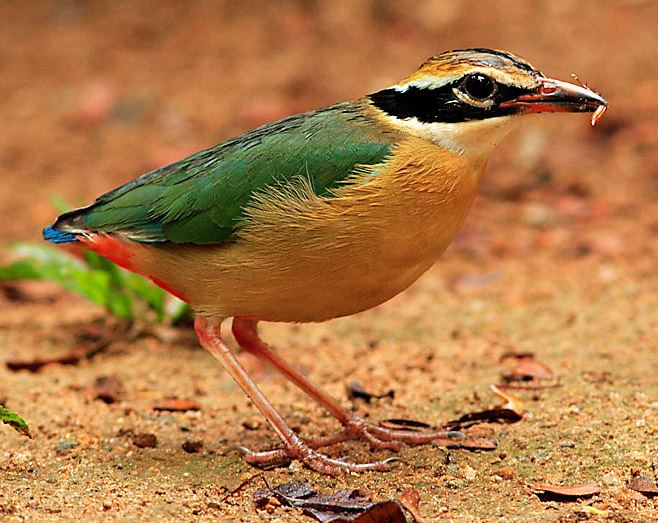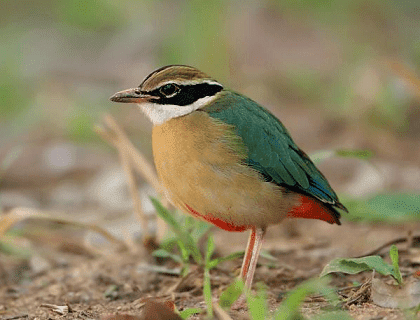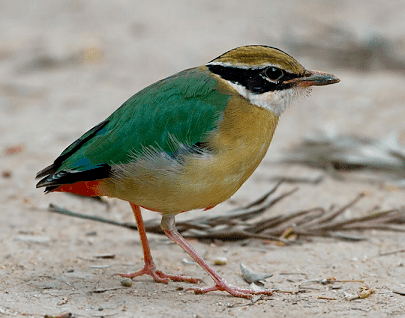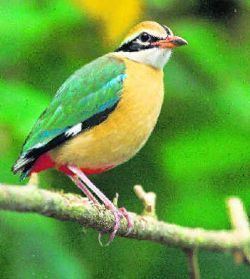Order Passeriformes Higher classification Pitta | Phylum Chordata Family Pittidae Scientific name Pitta brachyura Rank Species | |
 | ||
Similar Bird, Pitta, Blue‑winged pitta, Fairy pitta, Mangrove pitta | ||
Indian pitta a bird video
The Indian pitta (Pitta brachyura) is a passerine bird native to the Indian subcontinent. It inhabits scrub jungle, deciduous and dense evergreen forest. Breeding in the forests of the Himalayas, hills of central and western India, they migrate to other parts of the peninsula in winter. Although very colourful, they are usually shy and hidden in the undergrowth where they hop and pick insects on the forest floor. They have a distinctive two note whistling call which may be heard at dawn and dusk. It is considered Least Concern by IUCN as its range is very large.
Contents
- Indian pitta a bird video
- Indian pitta nesting
- Characteristics
- Etymology
- Distribution
- Ecology and behaviour
- References

Indian pitta nesting
Characteristics

The Indian pitta is a small stubby-tailed bird that is mostly seen on the floor of forests or under dense undergrowth, foraging on insects in leaf litter. It has long, strong legs, a very short tail and stout bill, with a buff coloured crown stripe, black coronal stripes, a thick black eye stripe and white throat and neck. The upperparts are green, with a blue tail, the underparts buff, with bright red on the lower belly and vent. The bird hops on the ground to forage and has been known to get trapped in ground traps meant for small mammals. It has been suggested that the width of the coronal stripe may differ in the sexes.

It is more often heard than seen and has a distinctive loud two-note whistle wheeet-tieu or wieet-pyou or sometimes, a triple note hh-wit-wiyu. They have a habit of calling once or twice, often with neighbouring individuals joining in, at dawn or dusk leading to their common name of "Six-O-Clock" bird in Tamil. When calling the head is thrown back and the bill is pointed upwards.

Pittas are among the few Old World suboscine birds. The Indian pitta is the basal member of a distinct clade that includes many of the Oriental species. It forms a superspecies with the fairy pitta (P. nympha), mangrove pitta (P. megarhyncha) and blue-winged pitta (P. moluccensis).
Etymology

The name pitta comes from the Telugu word meaning "small bird". Local names in India are based on the colours and their behaviours such as the time of calling and these include Hindi: Naorang, Punjabi: Nauranga (=Nine colours), Bengali: Shumcha, Cachar: Dao bui yegashi, Gujarati: Navaranga or Hariyo; Tamil: Arumani kuruvi (=6-OClock bird), Kathu-alechi (=Wind blown), Thotta kalla; Telugu: Polanki pitta, Ponnangi pitta; Malayalam: Kavi; Kannada: Navaranga and Sinhalese: Avichchiya. The Sinhalese interpretation of its call is that the bird is complaining about the theft of its dress by a peacock: “Evith giya, evith giya, ayith kiyannam, methe budun buduwana vita ayith kiyannam,” which translates as: “Came and went! Came and went! I’ll still be complaining when the next Buddha comes! I’ll still be complaining!”
Distribution

Indian pittas breed mainly in the Himalayan foothills from the Margalla hills northern Pakistan in the west to at least Nepal and possibly up to Sikkim in the east. They also breed in the hills of central India and in the Western Ghats south to Karnataka. They migrate to all parts of peninsular India and Sri Lanka in winter. Exhausted birds may turn up inside homes. They are rare in the drier regions of India.
Ecology and behaviour
Indian pittas roost in trees. They feed on insects and other small invertebrates that they usually pick up from the ground or leaf litter. They have also been noted to take kitchen food scraps from the ground.
They breed during the south-west monsoon from June to August, with peaks in June in central India, and in July in northern India. The nest is a globular structure with a circular opening on one side built on the ground or on low branches. It is made up of dry leaves and grasses. The clutch is four to five eggs which are very glossy white and spherical with spots and speckles of deep maroon or purple.
Avian malaria parasites have been noted in the species. Five out of thirteen birds in an ectoparasite survey were found to have the tick, Haemaphysalis spinigera.
Their seasonal movements associated with the rains have not been well studied.
